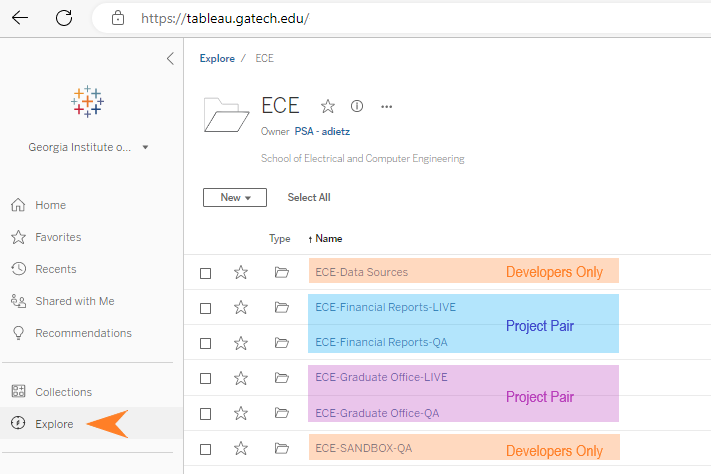Tableau Server Roles & Permissions
Roles in Tableau Server
Tableau Server users in each departmental tenant space have one of two primary roles.
Tenant Developers
Developers have read-write access to all folders within their Tenant Space. They can create, edit, and publish Tableau workbooks and data sources*. Please see the table below for a comprehensive list of Developer capabilities.
Viewers
Viewers have access to view and interact with visualizations and dashboards located in folders for which they are a member of the viewer group.
The EADI Platforms and Databases Team administers and maintains the list of Developers and lists of Viewers for each folder via Active Directory Groups.
Folder-Level Permissions
Permissions within the GT Enterprise Tableau Server are set at the folder level, not at the individual workbook or data source level. This structure simplifies access management.

Folder Structure
Each tenant department's top-level Project space in Tableau Server is composed of three basic elements:
Data Sources Folder
SANDBOX Folder
Project Folder Pairs (QA & LIVE)
Permissions for each of these folders are maintained by the EADI Platforms and Databases team.
Data Sources Folder
The Data Sources Folder is the designated location for publishing data sources. Workbooks cannot be published here; it exclusively holds data sources.
Developers must have an active Tableau Creator License to publish data sources, but both Creators and Explorers can connect to published data sources for visualizations.
The Data Sources folder is accessible only to unit developers and does not have a viewer group associated with it.
SANDBOX Folder
The SANDBOX Folder is intended for developers to experiment, build new visualizations, or test new features safely. It is restricted to unit developers, and there is no associated viewer group.
Developing & Sharing Reports
To share visualizations or dashboards with others, developers should follow these steps:
1. Determine Audience and Testers: Identify the intended audience for the visualizations as well as any users that should be able to test content that is under development.
2. Request Project Folder Pair: If they do not already exist, submit a request to the EADI Platforms and Databases Team to create two folders: A QA folder for developing workbooks that has the tester group as viewers and a LIVE folder with the intended audience group as viewers.
3. Develop in QA: Testers should be cautioned that these reports may contain content under development.
4. Publish to LIVE: Once workbooks are thoroughly tested and data accuracy is verified, developers can publish a copy from the QA folder to the LIVE folder. Workbooks in the LIVE folder must contain reliable, accurate data for viewers making business decisions.
Typical Report Development Workflow

User Role Comparison Table
Every user can view and interact with visualizations and dashboards on the web and mobile devices, including embedded content. See the full comparison table below.
Capability |
Viewers |
Developers |
|---|---|---|
Interact with visualizations and dashboards |
✔ | ✔ |
Download visualizations as images (.pdf, .png) |
✔ | ✔ |
Download aggregate data used by the visualization or dashboard |
✔ | ✔ |
Download full data set associated with the visualization or dashboard |
✔ | |
Access to Tableau Web Editor |
✔ | |
|
Create and publish new workbook connecting to |
✔ | |
Edit existing workbooks and visualizations |
✔ | |
Create and share custom views |
✔ | |
Access to Tableau Desktop & Tableau Prep |
✔* | |
Create and publish new data sources |
✔* | |
|
Create and publish new workbook with a |
✔* | |
*=Tableau Creator License Required |
||


